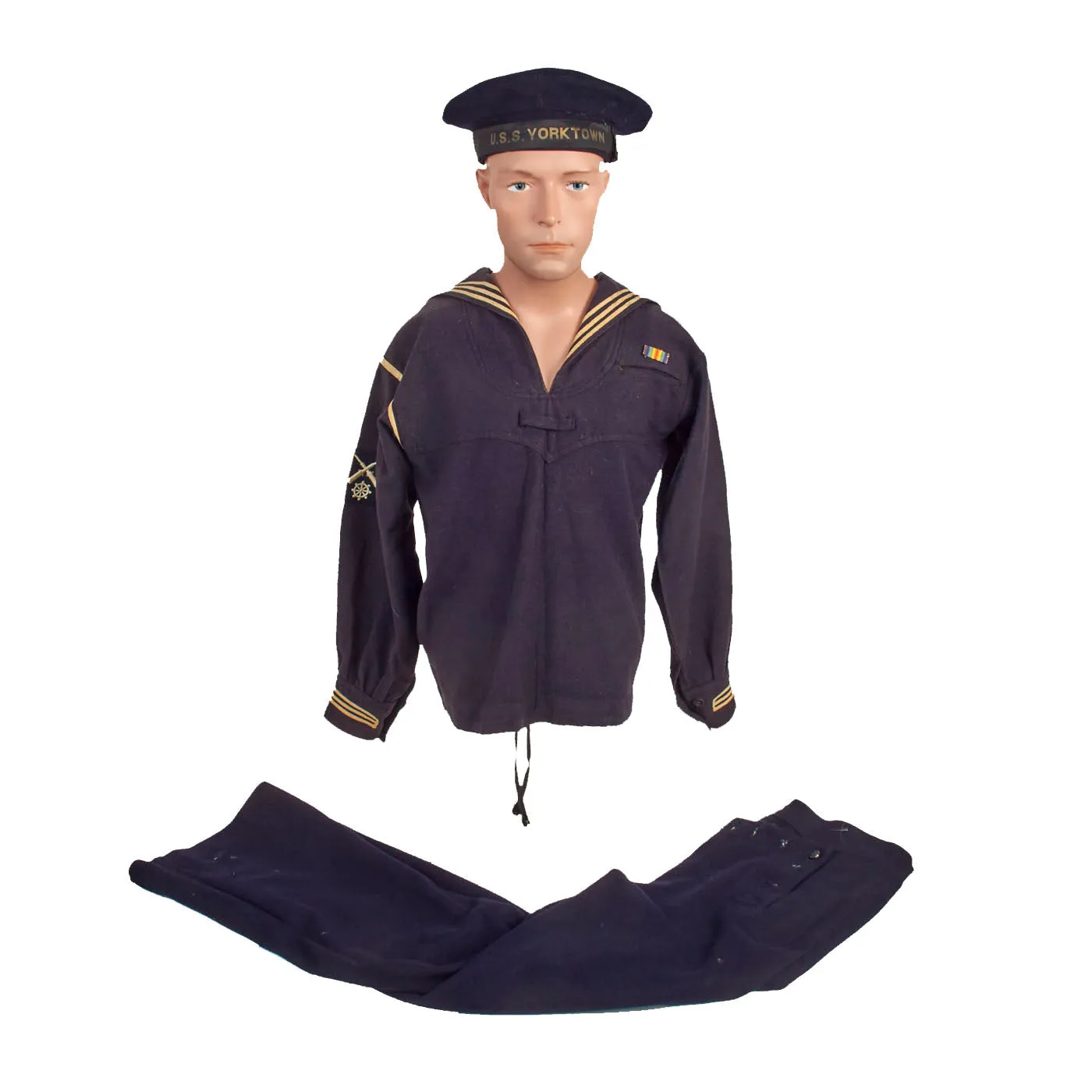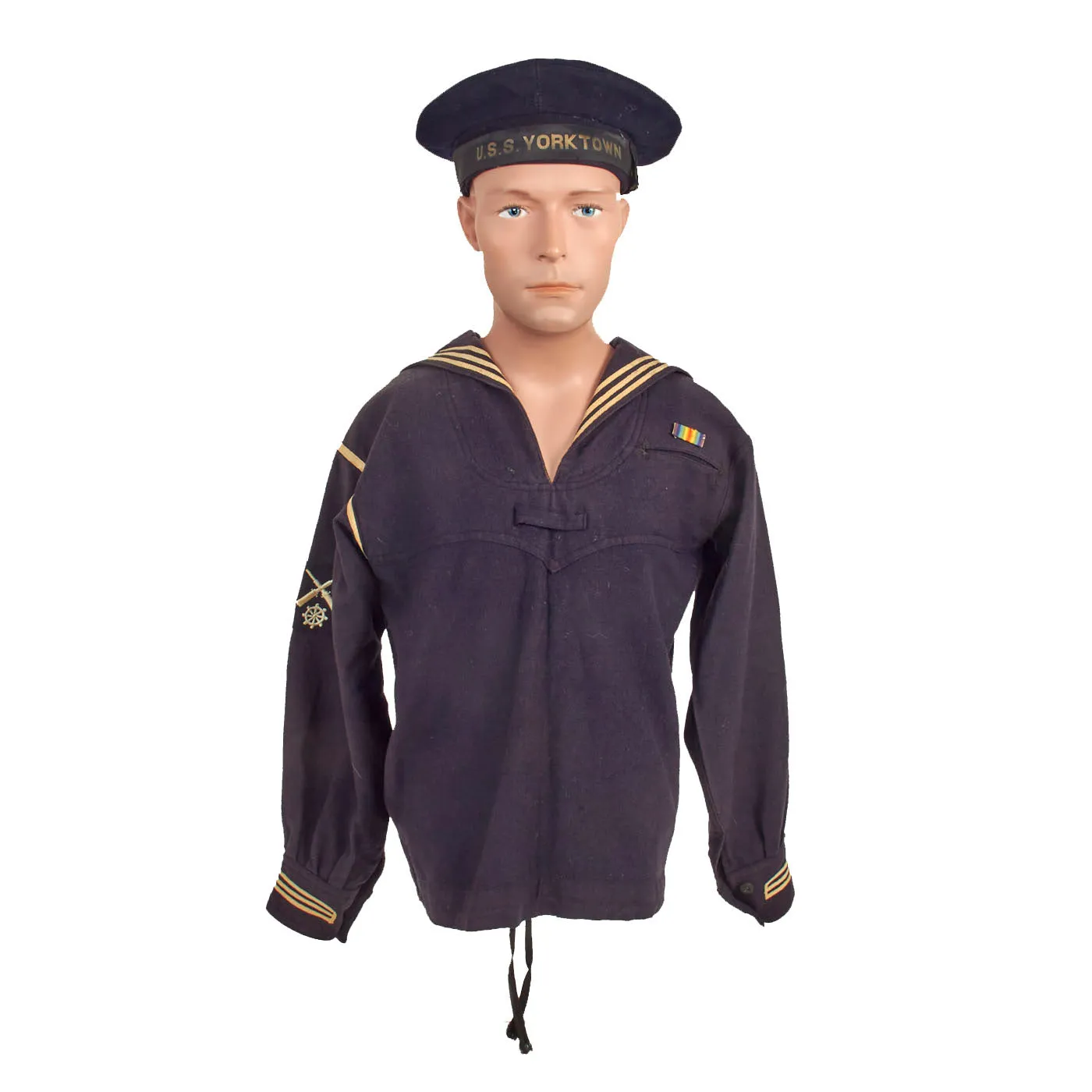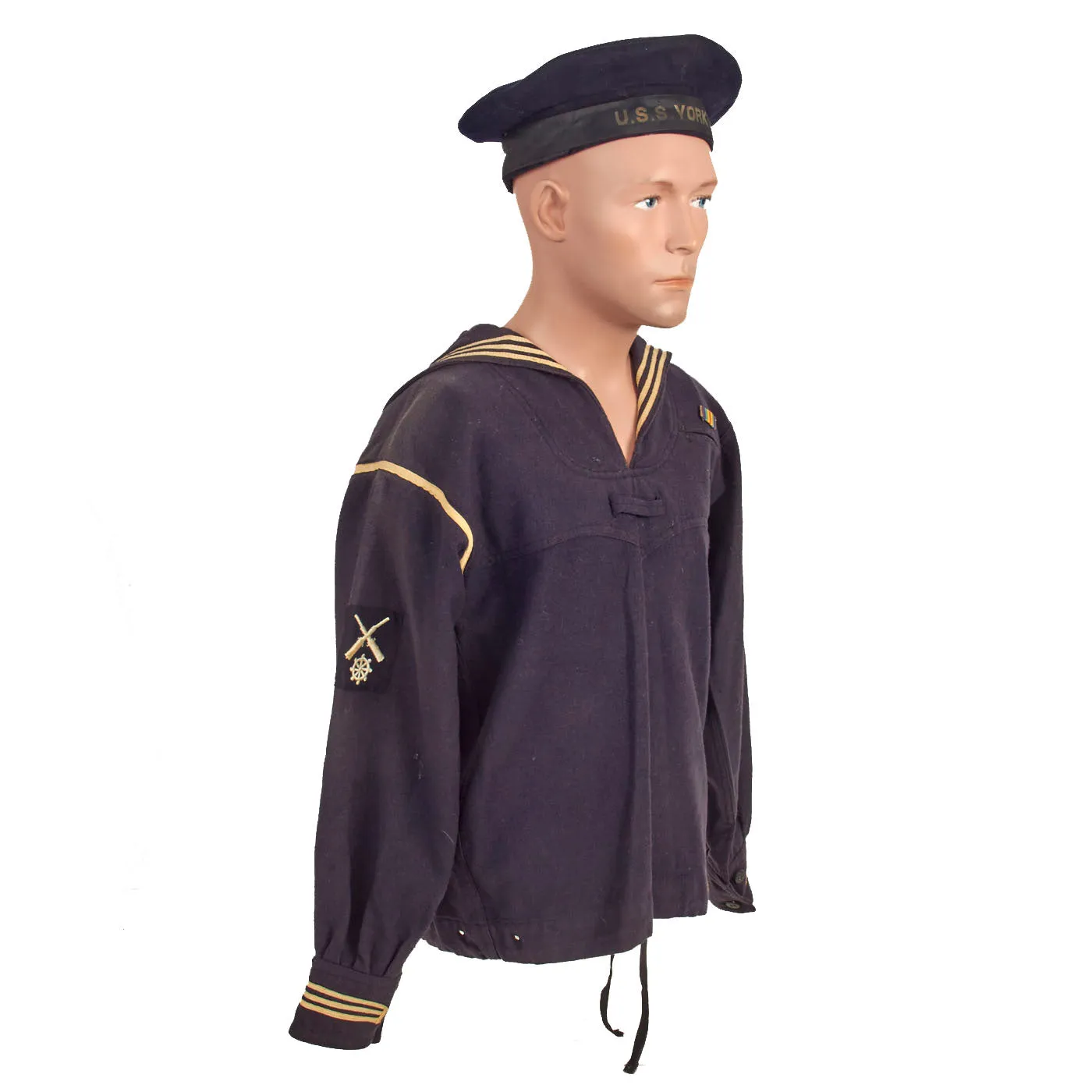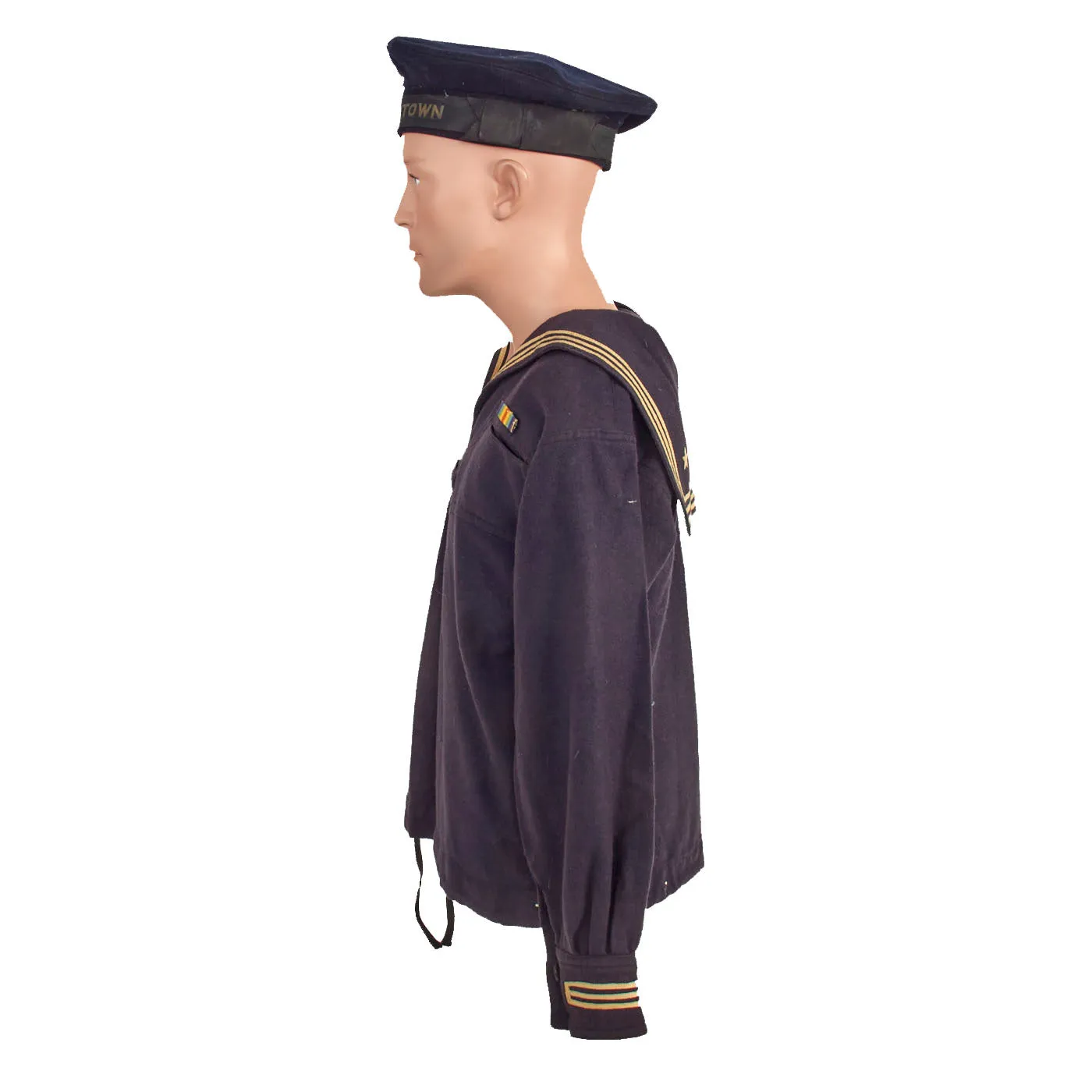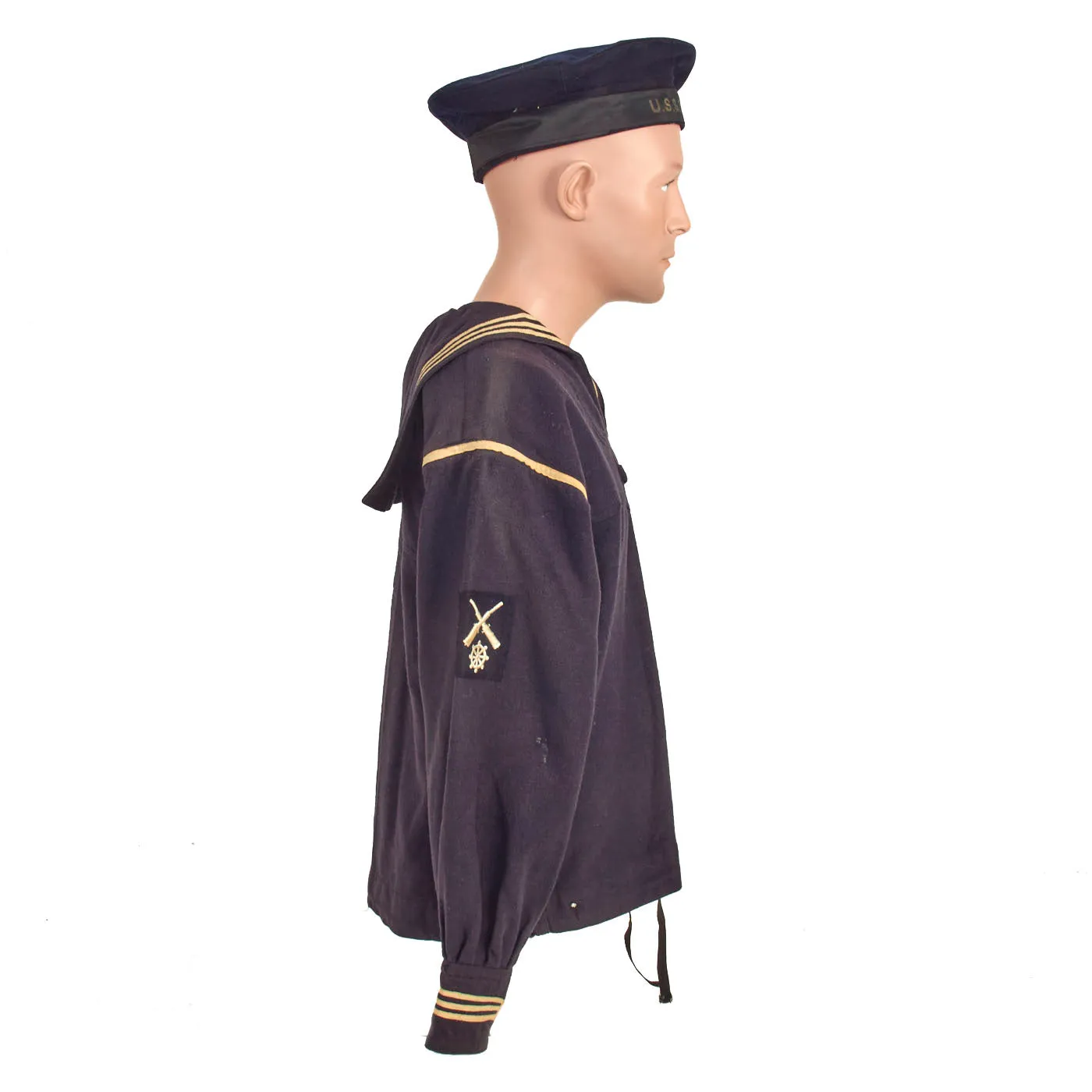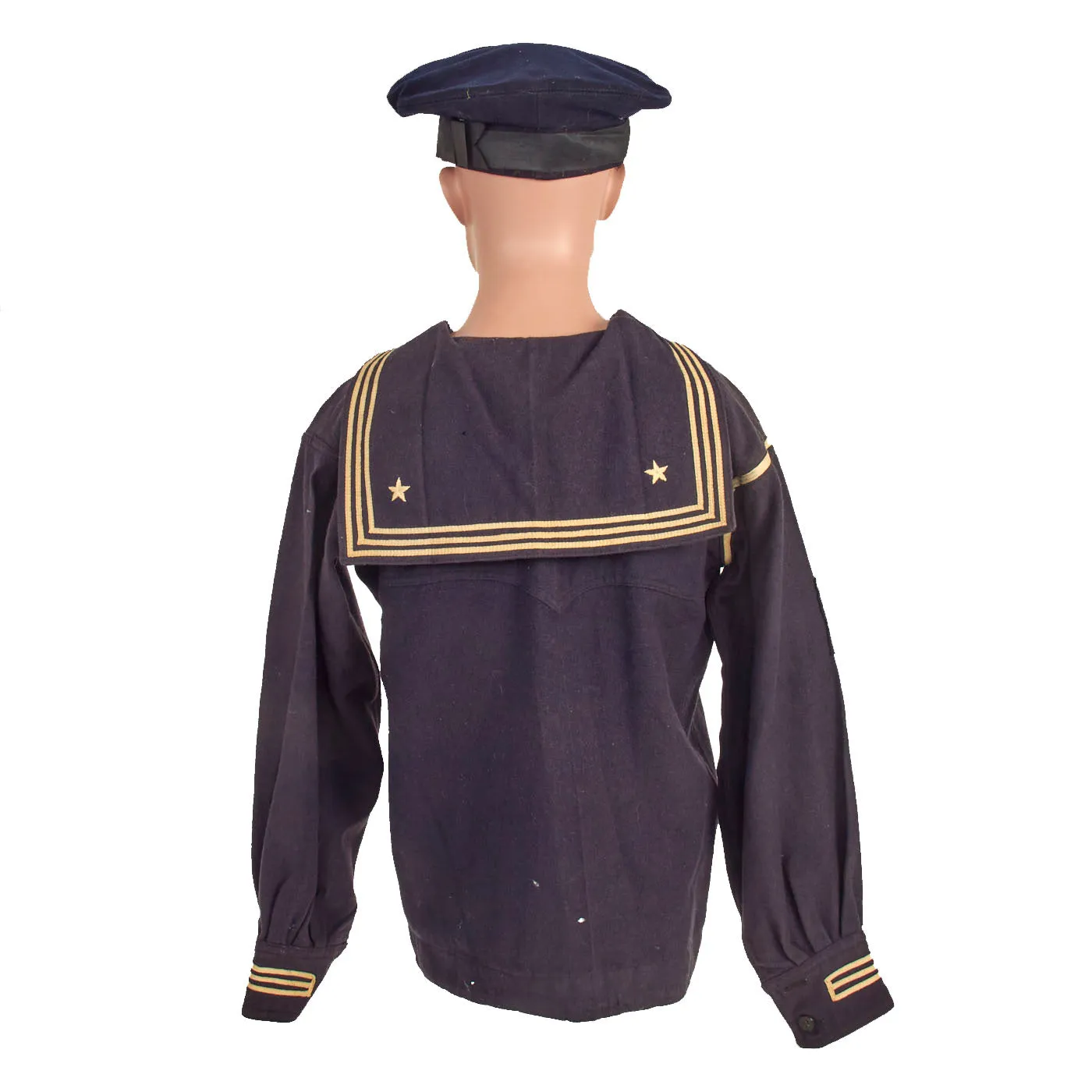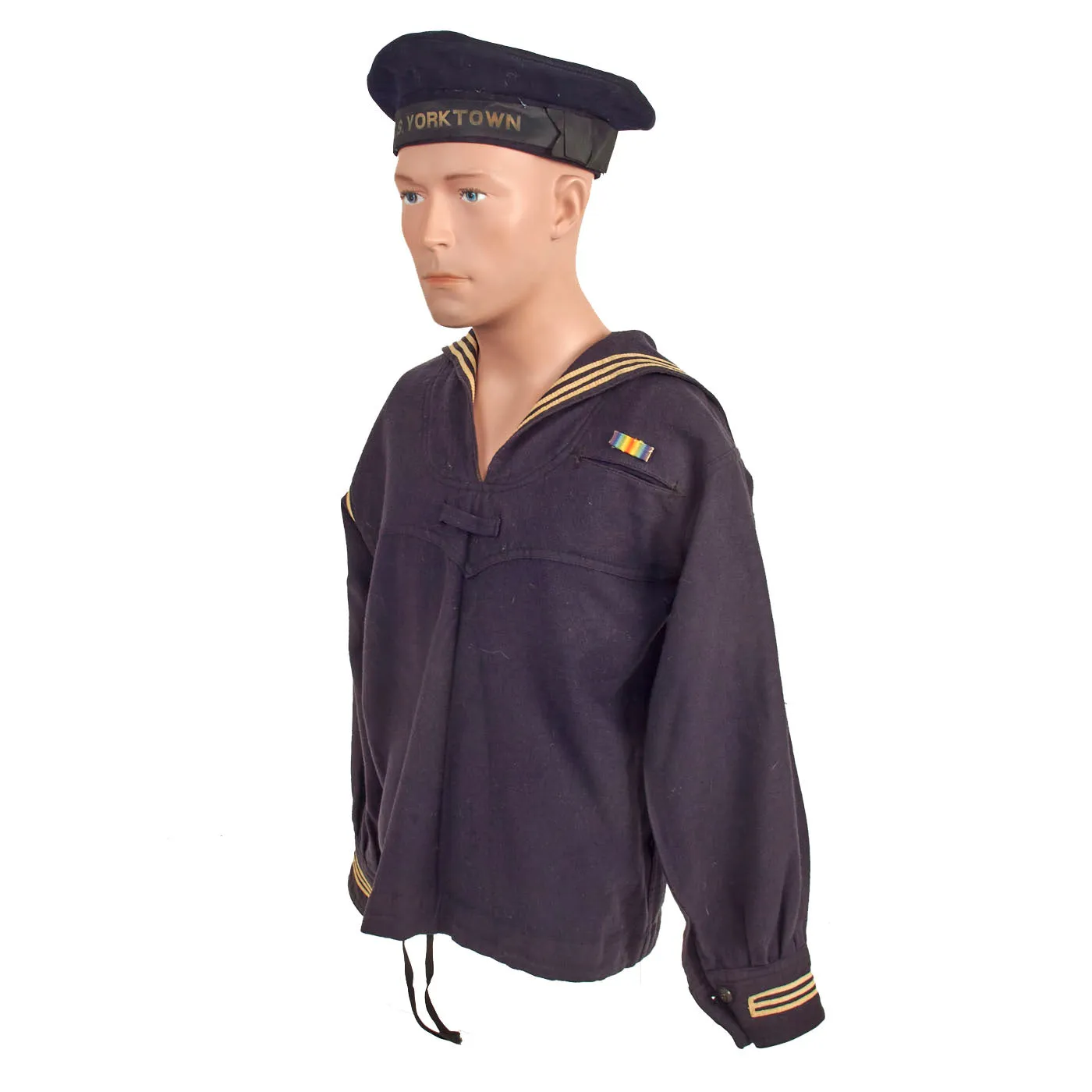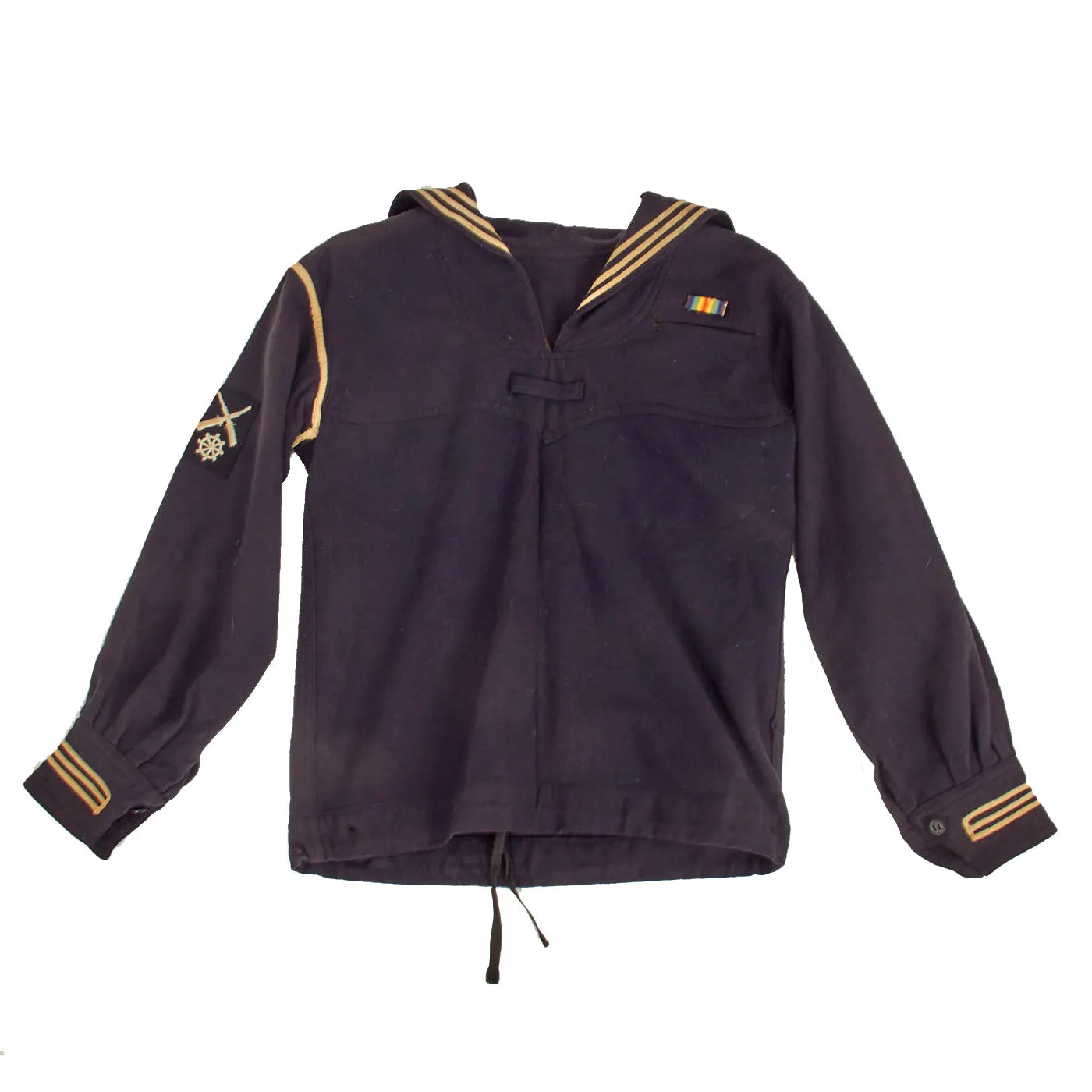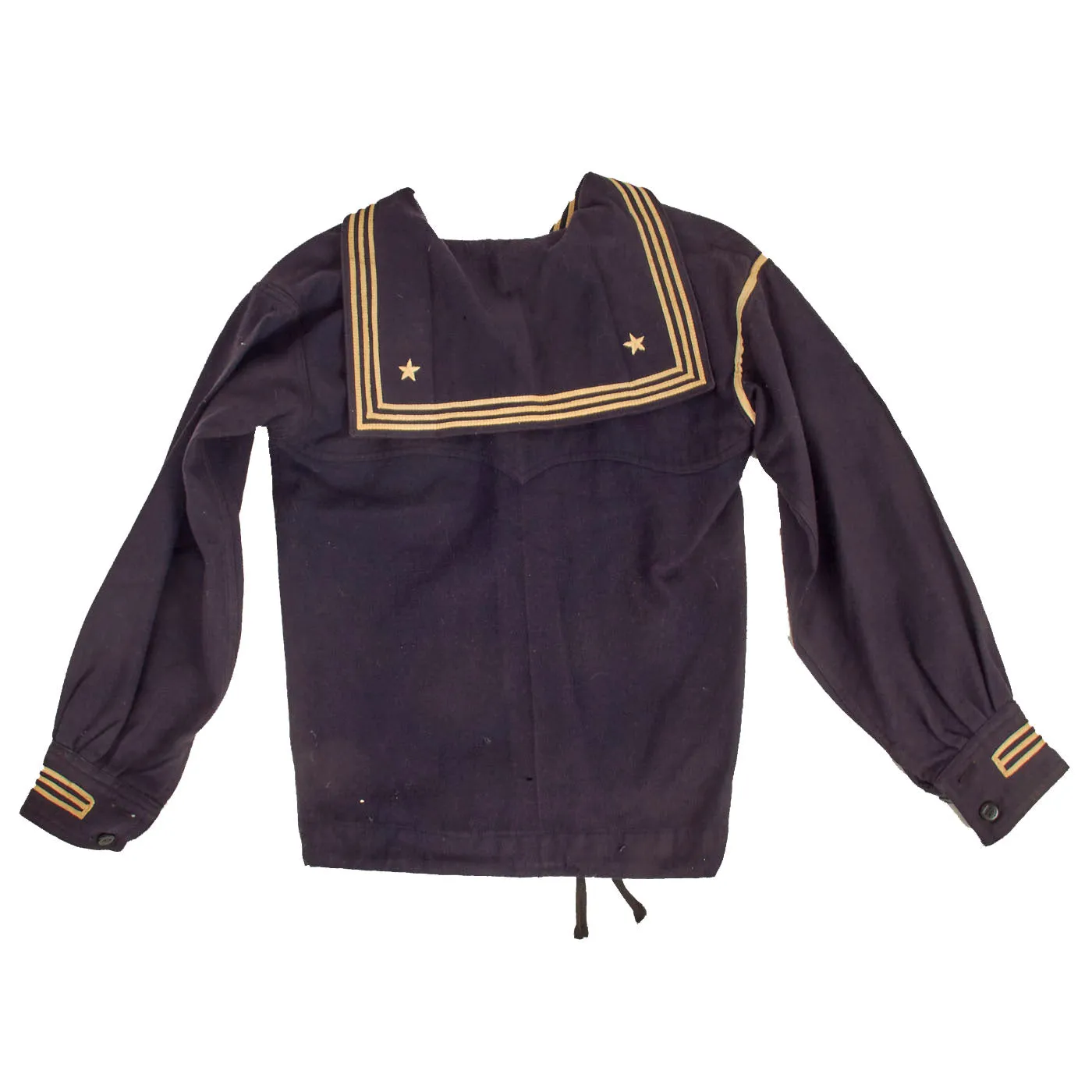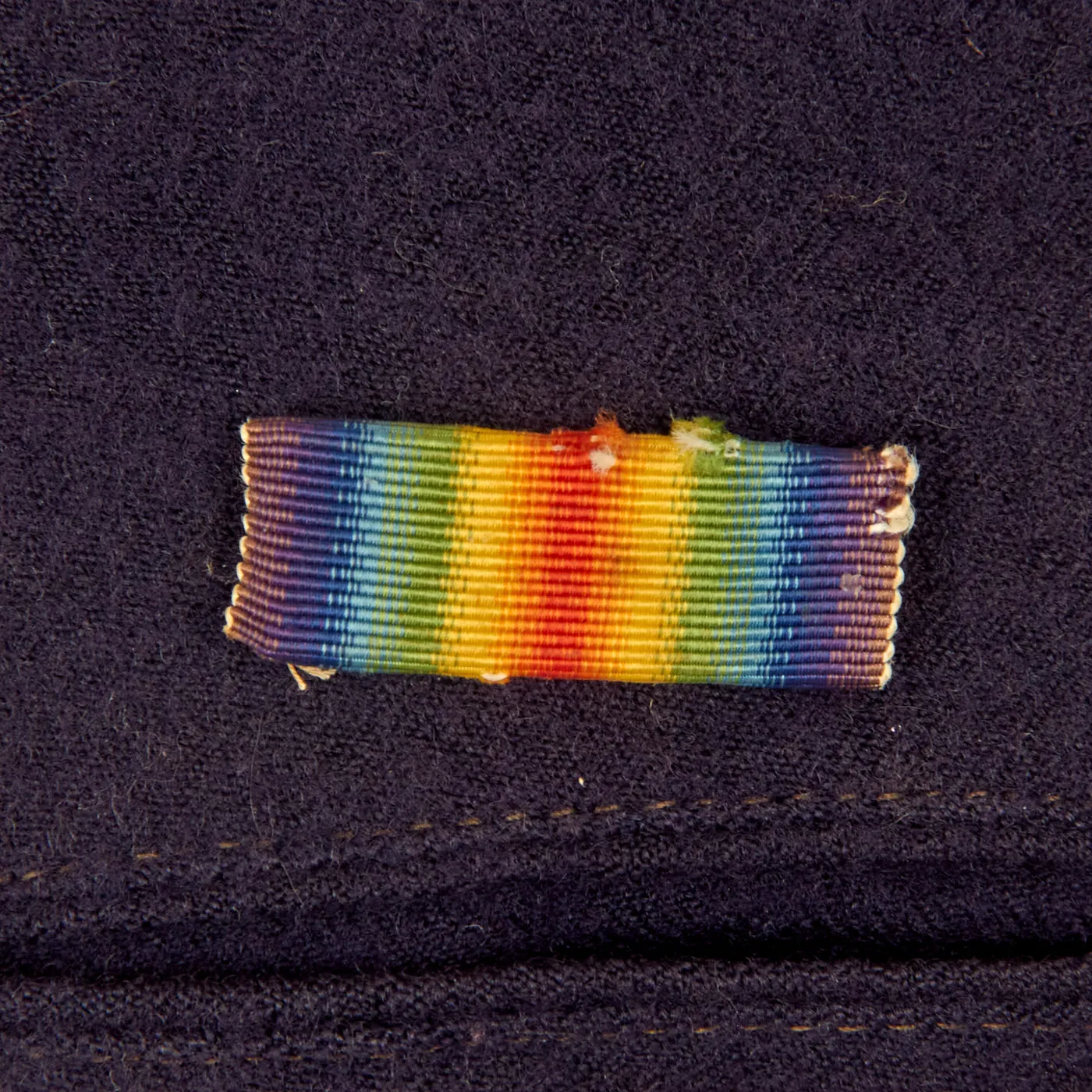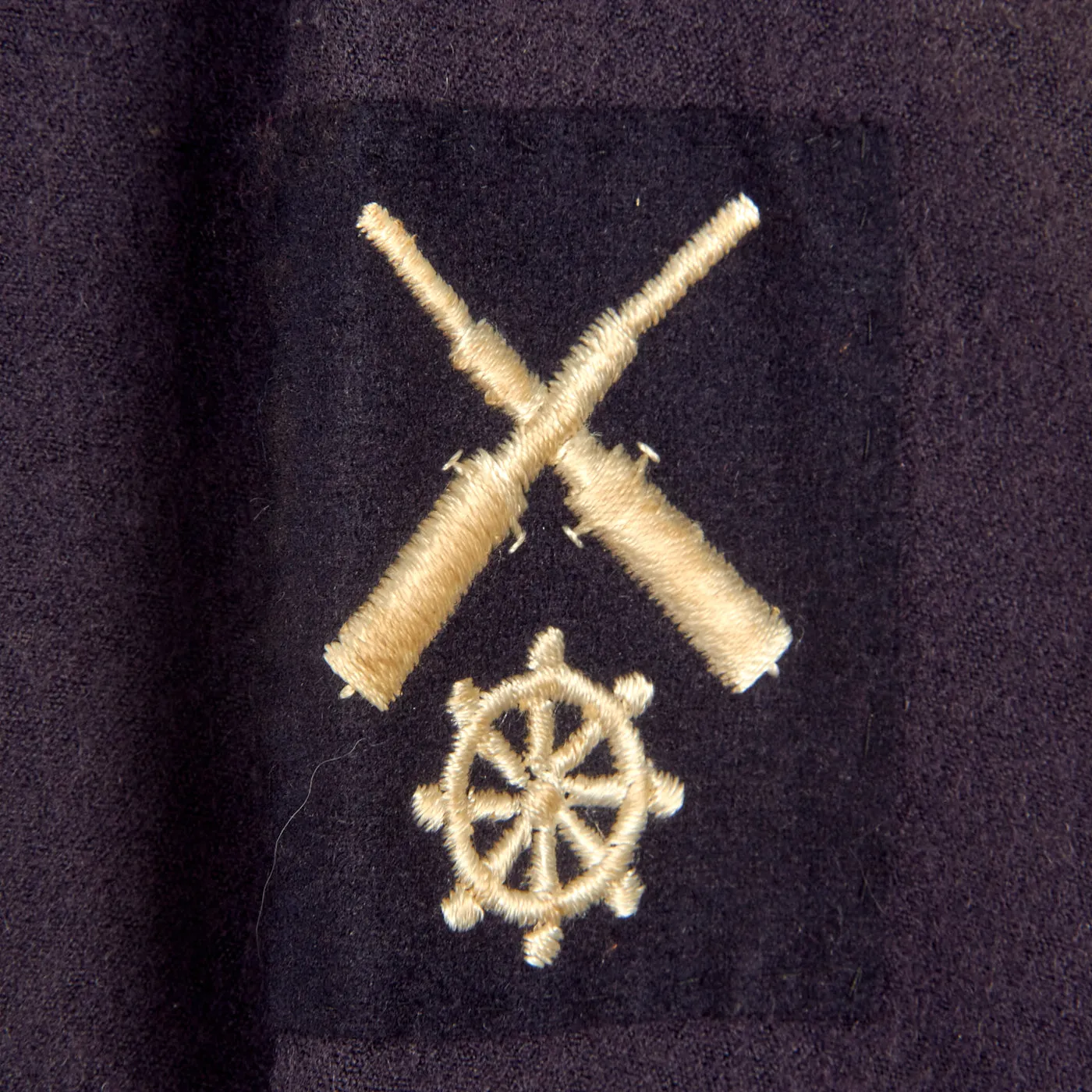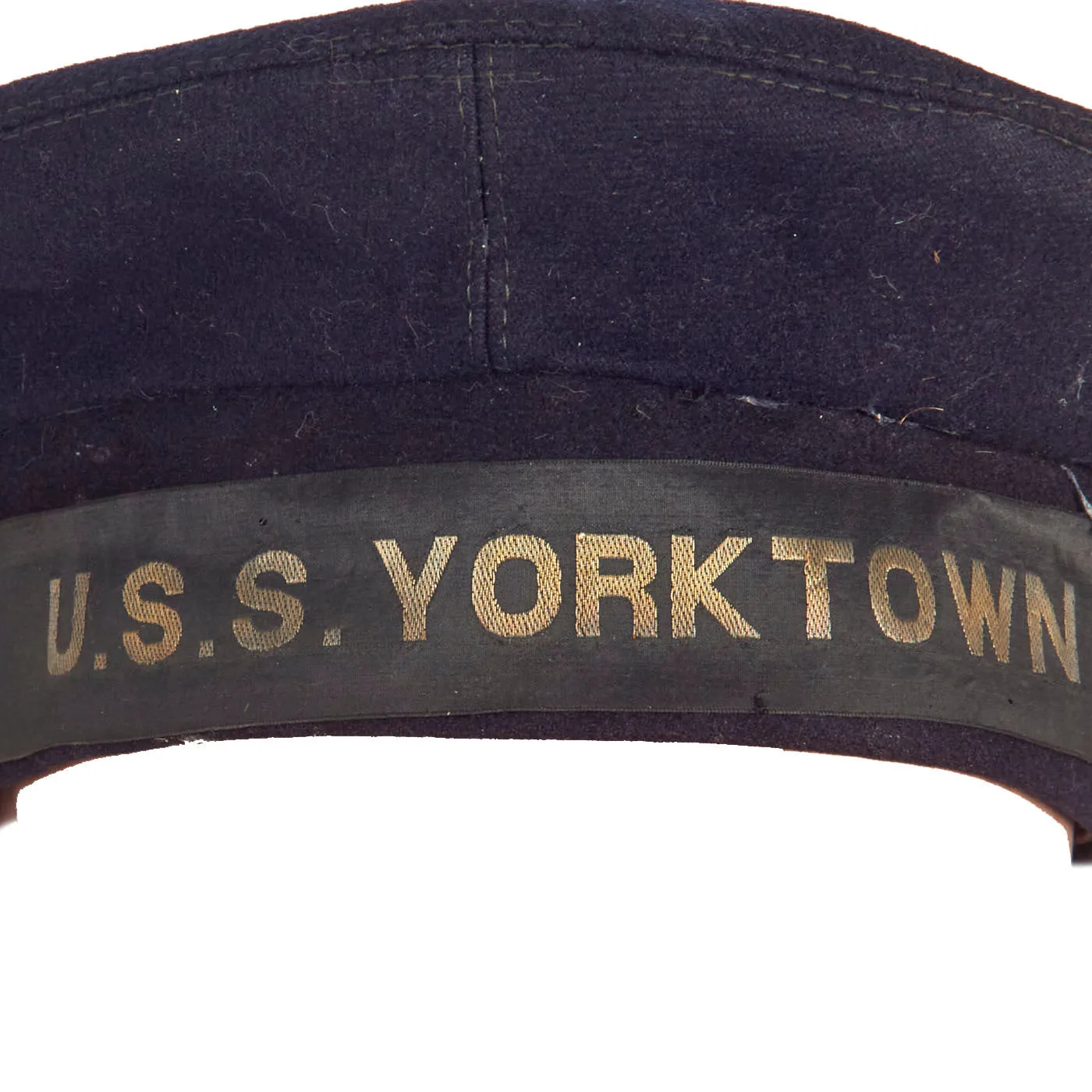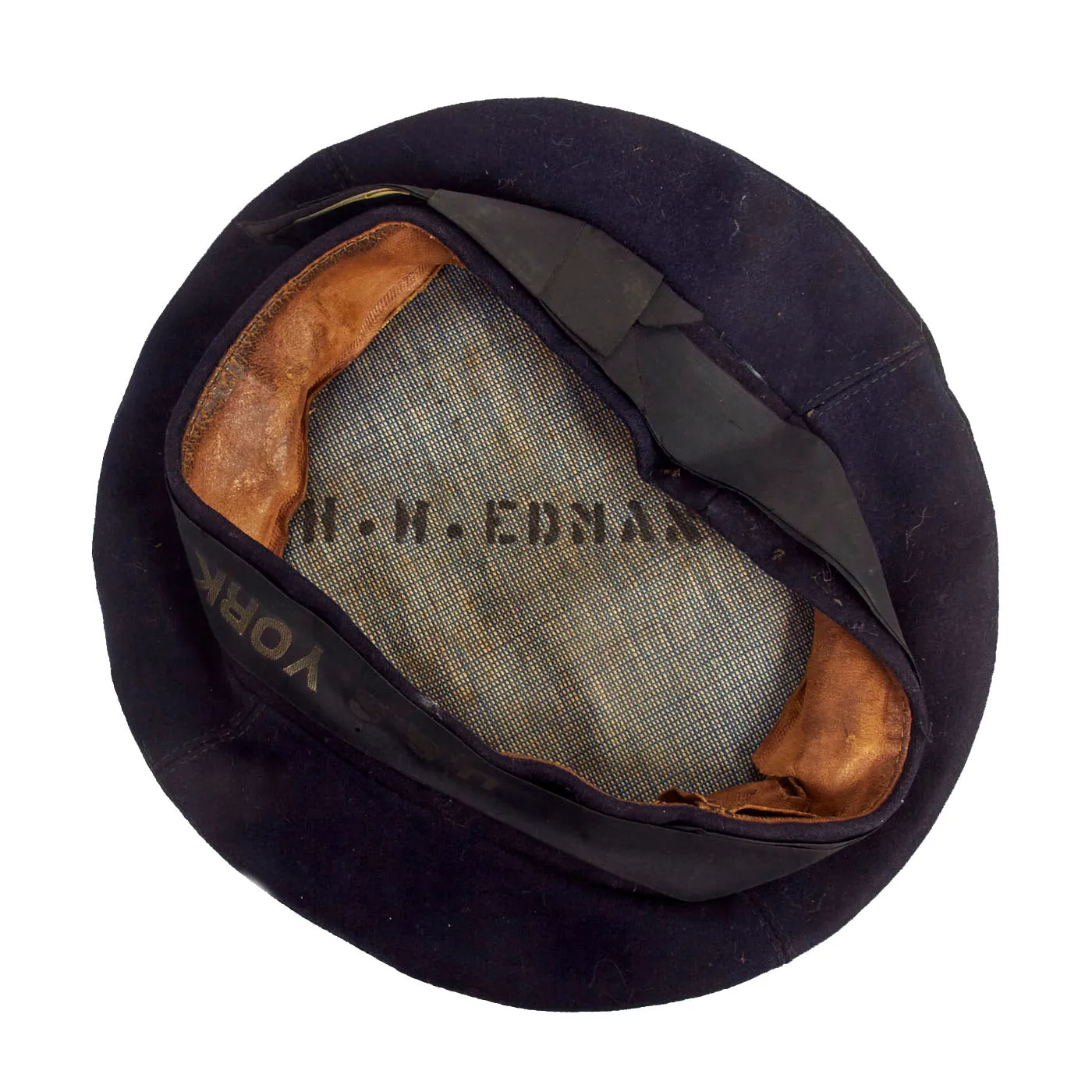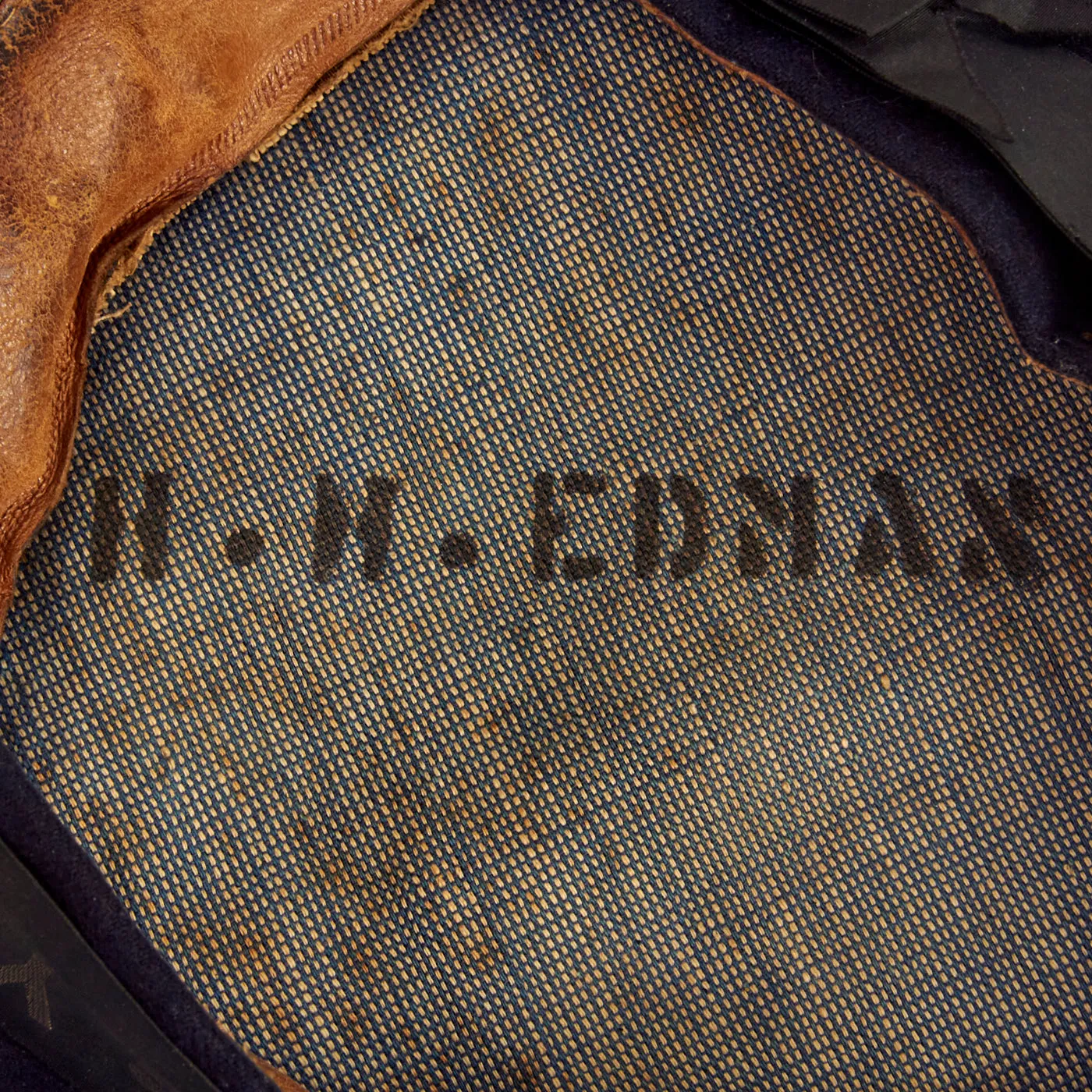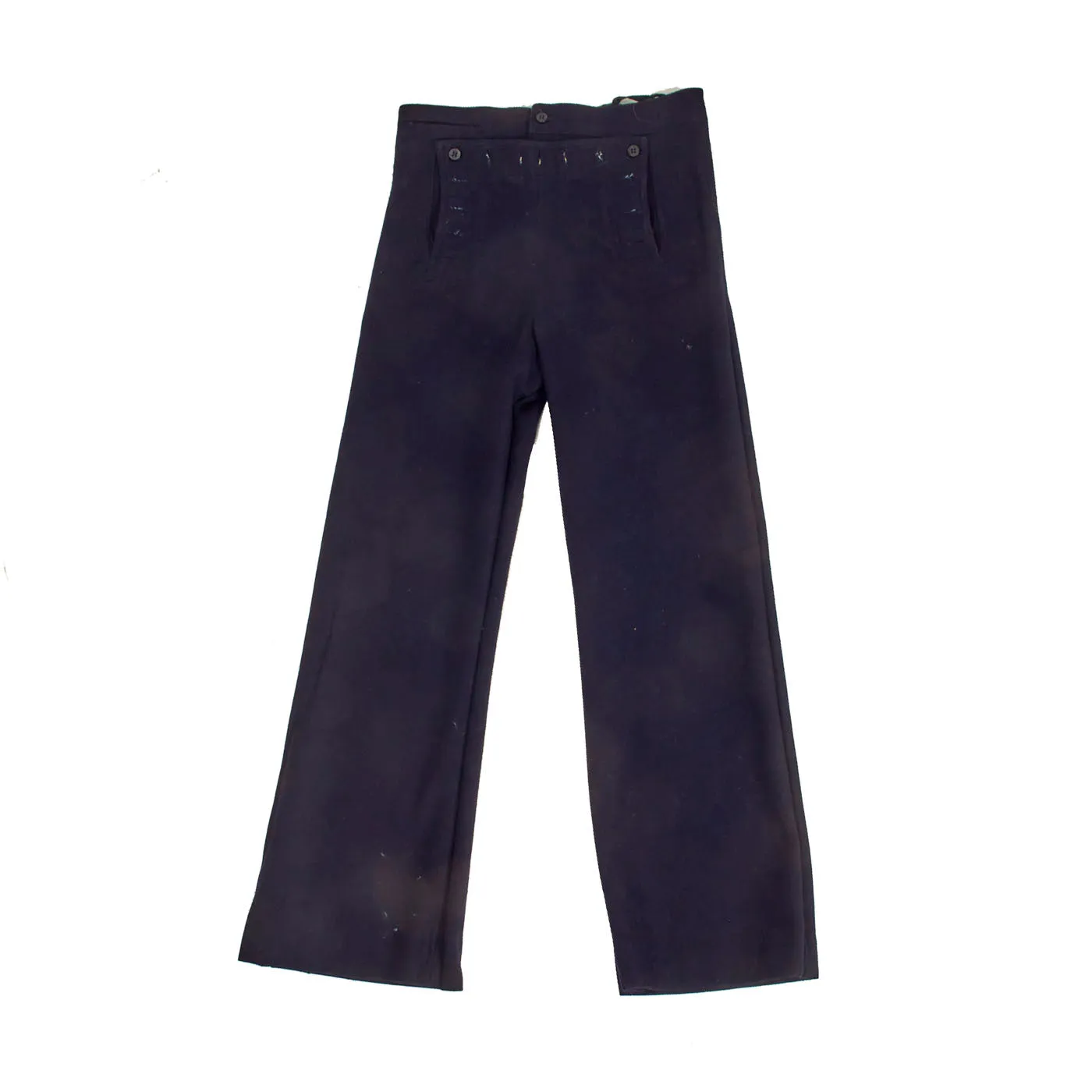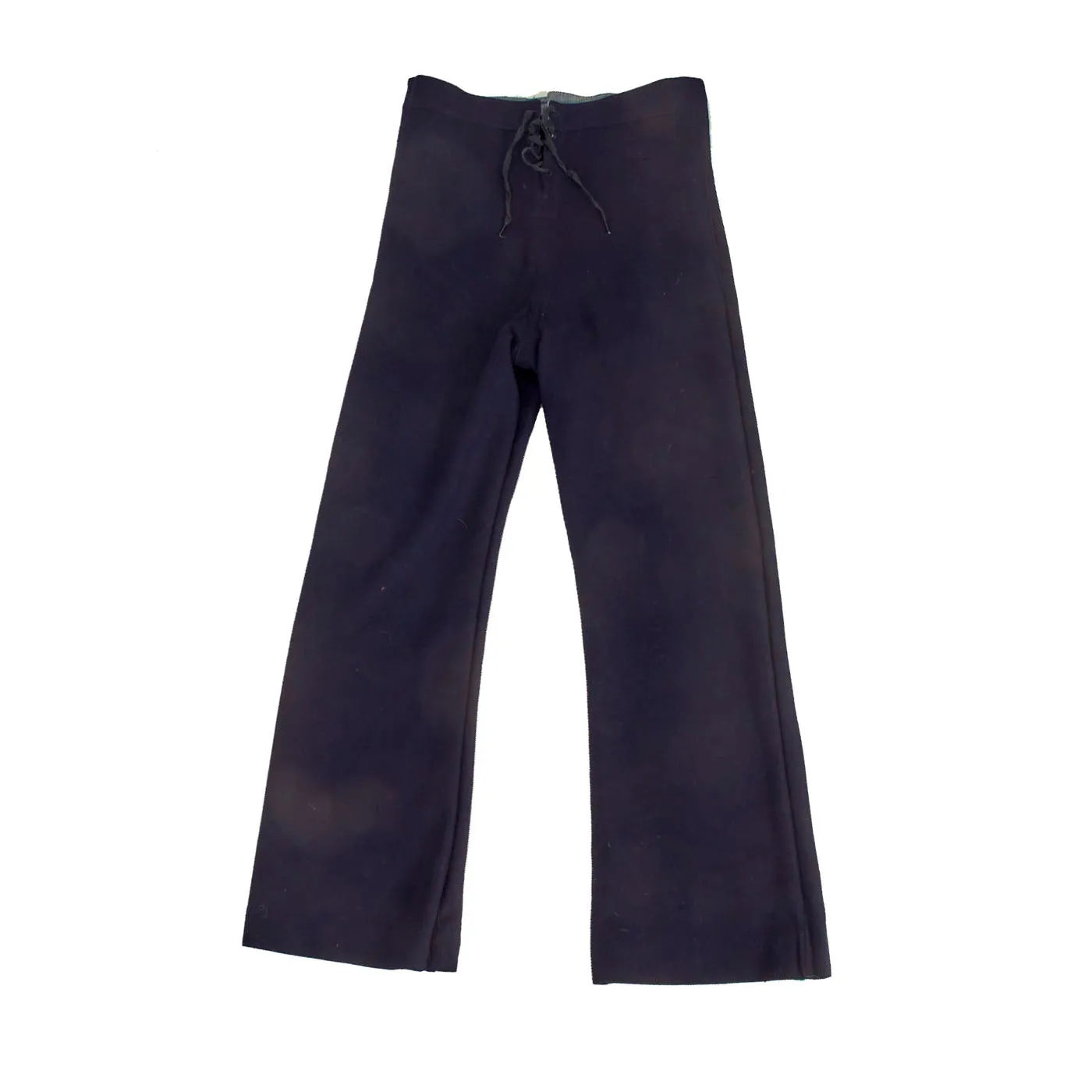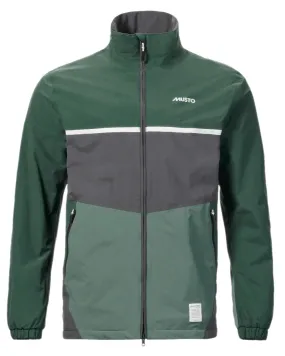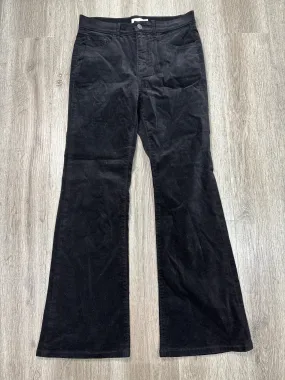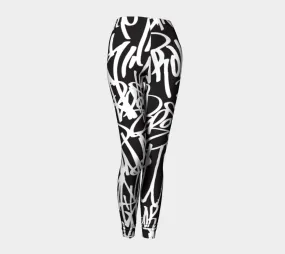Original Items: Only One Set Available. The US Navy dress blues have been in service for over 150 years and are still worn today. On a couple of occasions the Navy tried to replace the uniform. First, in the mid-40s, an "Ike" style uniform featuring a short jacket was tried out and was soundly rejected after its trial period. Then, between 1973 and 1980 the uniform was, in fact, briefly replaced with a more contemporary suit and visor cap design only to return to the tried-and-true dress blues. The uniform's main qualities of comfort, practicality, and a distinctive design have endeared it to the sailor. Iconic in appearance, the primary WW2 dress blue outfit consisted of a beret style cap with a ribbon and bow around the band; a "V" neck jumper with a square sailor's collar; a silk neckerchief; and bellbottom trousers with a 13-button broadfall front. Although its design features evolved from needs that had long since passed into history and were archaic even by WW2 standards, the uniform provided the sailor with an instantly recognizable uniform that boosted morale, evoked esprit de corps, and honored the Navy's proud history.
Photos dating back to at least the early 1860s show US sailors wearing a blue wool uniform not too different from the WW2 design. Through much of its early years the uniform was worn at sea, but by WW2 it had become mainly a dress uniform used for more formal occasions such as in formations, ceremonial activities, or for special guard duty. It was also worn on shore leave in appropriate climates. In fact, during WW2 it is most often seen being worn in northern shore and training stations by new recruits. The shift from a practical working uniform to one used for dress occasions was inevitable as military doctrine was evolving during the 1930s and 40s by setting specific roles for uniforms and establishing clear distinctions between work, garrison, and combat attire. And by the end of WW2 the age of multi-use uniforms had passed.
The dress blue jumper and trouser combination was considered a winter uniform to be worn in cool temperatures. It was constructed of high quality 16-ounce Melton wool that had a fine nap and was relatively soft to the touch. There were appropriate accessories to keep sailors warm on colder days. These included an overcoat made of matching heavy-weight Melton, blue wool knit gloves, and a blue wool muffler. The Dress Blue Uniform was included as part of the enlisted man's initial clothing gratuity. In northern training stations it was issued at induction and in warmer areas not until graduation was complete and final assignment received.
The dress blue uniform underwent continuous refinement over the decades of its use as was typically the case with uniforms that existed for any length of time. This process continued during WW2 with some significant changes being made to the jumper and trousers at the end of 1943. At this time it was decided to shorten the length of the jumper by six inches and simplify the waistband area of the trousers. These changes were implemented primarily to realize savings in a wartime economy by reducing the amount of fabric required to make the uniform and to speed up production by simplifying the manufacturing process.
The Dress Blue Uniform Items In This Grouping:
- Patched Gunner’s Mate Jumper and Trousers: The Gunner's Mate rating is primarily surface warfare-based. Closely associated Naval occupational ratings are Fire Controlman (FC), Aviation Ordnanceman (AO), Missile Technician (MT), Mineman (MN). The Gunner's Mate rating is one of the original ratings created as a result of the Naval Armament Act of 1794. The others include Boatswain's Mate (BM), Quartermasters (QM), Master-at-Arms (MA), and Yeoman (YN). The rating is also among the top five source ratings for enlisted Naval Special Warfare candidates.
The left breast features a single pinned on ribbon for the WWI Victory Medal, in wonderful condition. The right upper sleeve has a strange combination “dual rated” type of patch. The rate insignia is what appears to be a Gunner’s Mate as well as a Quartermaster, one we have not encountered before! The right shoulder has a white branch mark present. Enlisted men below the rank of petty officer wore stripes around the shoulder of their dress blue jumpers called Branch Marks. These stripes were made of ⅜-inch-wide white or red braid. Men assigned to the Seaman Branch wore a white braid on the right shoulder and men assigned to the Artificer Branch (Engine Room Force) wore a red braid on the left shoulder. Branch Marks were worn until the rank of Petty Officer was achieved, after which a Rating Badge was worn on the sleeve of the jumper. The cuff stripes indicate the rank of a Seaman 1st Class. Both the trousers and jumper are in good condition with minor moth nips and no significant damage.
- Pre-1933 USS Yorktown Flat Cap: The blue cloth cap was remarkable for its longevity having served as an essential part of the enlisted sailor's uniform for over one hundred years. During its considerable time in service, the blue cap sailed on frigates, sloops, paddle wheels, submarines, battleships, and aircraft carriers. It was present for the transition from sails to steam to fuel oil, and even lived to see the advent of nuclear propulsion. But perhaps, most of all, the cap brings back memories of great armadas, the age of Dreadnoughts, and the historic conflicts they partook in. Recorded in the Navy Uniform Regulations as early as 1833, the blue cap was originally part of an ensemble of clothing prescribed for enlisted seamen to be worn outdoors in both cold and warm weather. Early regulations simply described a "Blue Cloth Cap" until the Civil War period when the wording was slightly changed to "Blue Cloth Cap, without visor".
The circumference of the pre-1933 cap was much larger and required a wire stiffener on the inside to help keep its shape. Just like a lot of other sailors, the stiffener was removed to attribute a saltier appearance. The 1933 cap had a front riser that lifted the crown well above the ribbon. Additionally, the crown of the 1933 cap was attached to the sides using a cord seam, which is not present on this one. Prior to 1941, the vessel's name or any one of a number of different shore station designations could be displayed on the ribbon. In this case it's the Gunboat USS Yorktown (PG-1). The cap is in lovely condition and is even named on the inside with H. H. EDMAN stenciled into the top lining. Unfortunately we have not been able to locate any service information, making for a wonderful research opportunity.
This is truly a wonderful set of an early US Navy Dress Blue Uniform with a ship tallied flat cap! Comes more than ready for research and display.
Approx. Measurements:
Collar to shoulder: 9.5”
Shoulder to sleeve: 20”
Shoulder to shoulder: 17.5”
Chest width: 17.5”
Waist width: 18”
Hip width: 18”
Front length: 23.5"
Pants:
Waist:15.5"
Inseam: 28"
USS Yorktown (PG-1)
USS Yorktown was the lead ship of her class of steel-hulled, twin-screw gunboats in the United States Navy in the late 19th and early 20th centuries. She was the second U.S. Navy ship named in honor of the American Revolutionary War's Battle of Yorktown.
Yorktown was laid down by William Cramp & Sons of Philadelphia in May 1887 and launched in April 1888. She was just over 244 feet (74 m) long and 36 feet (11 m) abeam, and displaced 1,710 long tons (1,740 t). She was equipped with two steam engines which were supplemented with three schooner-rigged masts. The ship's main battery consisted of six 6-inch (15.2 cm) guns and was augmented by an assortment of smaller-caliber guns.
At launch, Yorktown joined the Squadron of Evolution of "New Navy" steel-hulled ships. Detached from that squadron, Yorktown, under the command of Robley D. Evans, sailed to Valparaíso, Chile, during the 1891 Baltimore Crisis and relieved USS Baltimore at that port. After that situation was resolved, Yorktown took part in the joint British–American sealing patrol in Alaskan waters and duty on the Asiatic Station before returning to the United States in 1898. Yorktown was out of commission during the Spanish–American War, but took part in actions in the Philippine–American War and the Boxer Rebellion in 1899 and 1900, respectively, after she had been recommissioned.
After three years out of commission from 1903 to 1906, Yorktown hosted the Secretary of the Navy on board when he greeted the Great White Fleet on its arrival in San Francisco in May 1908. Over the next five years, most of Yorktown's time was spent in sealing patrols in Alaska and duty in Latin American ports. From July 1912, Yorktown was out of commission for alterations, but resumed duties off the Mexican, Nicaraguan, and Honduran coasts beginning in April 1913. Through World War I, Yorktown continued in the same role, until she departed for the East Coast of the United States in April 1918. She served as an escort for one convoy headed to Halifax in August, and remained in coastal escort duties in the east until January 1919. After arrival at San Diego in February, she was decommissioned for the final time in June 1919, and was assigned the hull number PG-1 the following year. She was sold in 1921 to an Oakland, California firm and broke up that same year.
Recommissioned on 1 April 1913, with Commander George B. Bradshaw in command, Yorktown operated out of San Diego on shakedown into mid-April. She was soon back at Corinto, however, remaining in Nicaragua until 5 June. After a brief period of operations off the coast, she returned to Corinto on 21 June and remained there for over a month before departing on 31 July to coal at Salina Cruz, Mexico. She moved to Mazatlán on 10 August and there picked up mail, delivering it to the port of Topolobampo, Mexico, on the 11th. Yorktown remained there until mid-September.
For the remainder of 1913, Yorktown conducted local operations out of San Diego and San Francisco. In January 1914, though, the gunboat returned to Mexican waters and investigated local conditions at Ensenada between 3 and 6 January before moving, in subsequent months, to a succession of Mexican ports: Mazatlán, San Blas, Miramar, Topolobampo, and La Paz. Following an overhaul at Mare Island from 24 June to 2 September 1914, Yorktown served in Mexican waters again into June 1915. From that point until the entry of the United States into World War I in April 1917, Yorktown continued her routine of patrols off Mexican, Nicaraguan, and Honduran ports with occasional repairs at Mare Island and maneuvers out of San Diego.
After the United States joined the Allies, Yorktown operated off the coast of Mexico until August 1917, when she paused briefly at San Diego. On 18 July 1917, Yorktown rescued the last surviving members of an abandoned guano mining settlement on Clipperton Island. From a peak population of roughly 100 in 1915, only four women and seven children survived. After her time off the Mexican coast, Yorktown then cruised off the west coasts of Central and South America into 1918. After a refit at Mare Island, Yorktown, sailed for the east coast on 28 April 1918, transiting the Panama Canal en route, and arrived at New York on 20 August. The gunboat escorted a coastal convoy to Halifax, soon there after before returning to New York. She performed local coastwise escort duties through the end of World War I. After a period of upkeep at the New York Navy Yard in December, she departed the east coast on 2 January 1919 on her last voyage to California.
Arriving at San Diego on 15 February 1919, Yorktown was placed out of commission at Mare Island on 12 June 1919. On 17 June 1920, she was assigned the hull number PG-1. The veteran steel-hulled gunboat was sold to the Union Hide Company of Oakland, California, on 30 September 1921; she was broken up in Oakland sometime after that.




